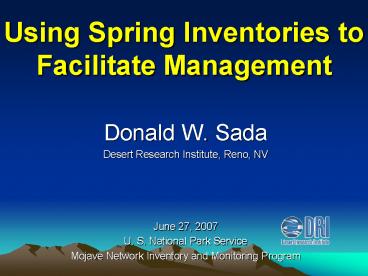Using Spring Inventories to Facilitate Management - PowerPoint PPT Presentation
1 / 28
Title: Using Spring Inventories to Facilitate Management
1
Using Spring Inventories to Facilitate
Management
- Donald W. Sada
- Desert Research Institute, Reno, NV
- June 27, 2007
- U. S. National Park Service
- Mojave Network Inventory and Monitoring Program
2
Groundwater Research
- Chemistry
- Aquifer Provenance, Water Age, Dimensions, etc.
3
Biological Research
- RECENT
- Macroinvertebrate
- Riparian Communities
- Community Ecology
- Crenobiontics
- Taxonomy
- Biogeography
- Ecology
- Demography
- Effects of Stressors
- HISTORICAL
- Fish
- Taxonomy
- Biogeography
- Physiology
- Conservation Biology
- Life History
- Ecology
4
Importance of Springs
- Ecology is Closely Associated with Physiochemical
Characteristics of Groundwater Systems and
Environmental Stress - Biodiversity Cultural Hot Spots in Arid Lands
(Native Americans, Rural Economies, Birds,
Mammals, Riparian Vegetation, Aquatics) - Sole Habitat for Crenobiontic
Species (Springsnails, Fishes, Aquatic
Insects, etc.)
5
(No Transcript)
6
Natural and Human DisturbanceN 1590
7
The Conceptual Challenge
- So many (survey, manage)
- Broad diversity of types, sources, landscapes
- Most in degraded condition
- Historically not considered to be important
biological resources - Limited knowledge of physicochemical-biological
relationships
8
The Practical Challenge
- Locate resources
- Identify/prioritize problems and issues
- Design implement management
- Restoration
- Monitoring
- Rare species
- Design conduct appropriate research
9
Spring I and M Program
- Develop inventory and monitoring protocols
- Characterize resources
- Size
- Access
- Stressors (Natural Human)
- Location
- Physicochemical attributes
- ID location of rare species
- ID potential management issues
- Prioritize management restoration programs
- Inventory water features (springs, wells, etc.)
- Compile information in reports and common database
10
I M Protocol
- Level I
- Reconnaissance survey, infrequent
- Locate, characterize aquatic riparian
environments, ID presence and absence of
important species - 15 data elements
- Level II
- Periodic visits (e.g., annual, biannual, every 5
years) - Quantitatively assess physiochemical environment
and aquatic and riparian community structure - Level III
- Long term and more frequent (e.g., Seasonal)
- Quantitatively document spatial temporal
variation in community structure, demography, and
environment (aquatic riparian) - Quantify habitat preferences for important
(indicator) species
11
What is a Spring ?
- Aquatic system supported by water traveling
through a confined geology and discharging onto
the land surface through natural processes
12
Springs vs. Streams
- Springs
- Relatively static
- Discharge
- Water Temperature
- Water Chemistry
- Turbidity
- Etc.
- Weak hydraulic processes
- Streams
- Relatively variable
- Discharge
- Water temperature
- Water chemistry
- Turbidity
- Etc.
- Strong hydraulic processes
13
Arid Land Aquifer Generalities
- Mountain
- Small (Watershed)
- Springs Discharge on Mountain or Ridge Blocks
- Short Residence Time (seasonal or annual)
- Many Not Persistent, Frequently Dry
- Local
- Larger (Mountain Range)
- Springs Discharge at Lower Elevations (Bajada or
Valley Floor) - Elevated Residence Time (gt annual)
- Persistence gt 20 yr.
- Regional
- Large (Basin Range)
- Springs Discharge on Valley Floor
- Long Residence Time (millennial)
- Geologically Persistent
14
Ecologically Important Stresses
- NATURAL
- Persistence
- Chemistry
- pH
- Conductance
- Temperature
- Solute Concentrations Ratios
- Disturbance
- Flood
- Fire
- Avalanche
- Etc.
- ANTHROPOGENIC
- Diversion
- Pipe
- Channelization
- Impoundment
- Groundwater use
- Non-native species
- Ungulates
- Cattle, Horses, Burros
- Aquatics
- Vertebrates
- Fishes, Amphibians
- Invertebrates
- Crayfish
- Mollusks
15
Ecological Effect of Stressors
- Relative to
- Magnitude
- Frequency
- Duration
High
Richness
Tolerance
Low
Stress
16
ResultsMojave Network Water Features
- Death Valley637
- Joshua Tree156
- Grand Canyon-Parashant228
- Lake Mead80
- Great Basin210
- Mojave Preserve183
- Manzanar0
17
DEVA Water Features
18
Location of DEVA Springs
19
Basic Water Chemistry
20
Basic Biological Characteristics
21
Stressors
22
DEVA Summary
- Large number of springs over wide area and fed by
different aquifers - Mostly small
- Many stressed and unstressed by natural and human
factors - Drought
- Flooding
- Diversion
- Ungulates
- Wide diversity of important riparian and aquatic
species
23
Identify Priority Monitoring Sites
- Highest biological richness
- Persistent aquatic systems
- Largest springs (highest discharge longer brooks)
- Presence of obligate spring dwelling inverts
- Minimally stressed by natural human factors
- Easy access
24
Monitoring PrioritiesMatrix Analysis
- Presence of Important Aquatic Species
- Absent 1, Present 10, gt1 Present 15
- Ease of Access
- 1 or 2 0, 3 5, 4 10, 5 15
- Spring Brook Length
- gt 500 m 10, lt 500 gt 200 7, lt 200 gt 50 5, lt
50 2 - Scouring
- None 10, Occasional 5, Frequent 0
- Aquatic Habitat Persistence
- Persistent 10, Ephemeral 0
- Stressor Level
- Unstressed/Slight 10, Moderate 2, High 0--
25
Priority Monitoring Sites
Saratoga Spring DV
Grapevine Ranch Springs DV
Salt Creek DV
Badwater Springs Province DV
Annie Oakley Spring DV
McLean Spring DV
Travertine Springs Province DV
Upper Hall Canyon Spring PV
Unnamed Darwin Hills DV
Waucoba Spring SV
Flicker Spring DV
Bangbang Spring DV
26
Summary
- Level 1 Inventories characterize environmental
and biological features of individual springs - Over an area, this information can be used to
- Identify management issues
- Prioritize management
- Prioritize restoration
- Qualitatively describe baseline conditions for
future monitoring
27
What Next?
- Understand spatial and temporal variation in
biotic and abiotic systems - Quantify reference conditions
- Implement holistic monitoring
- Quantify relationship between stress levels and
environmental and biological integrity
28































